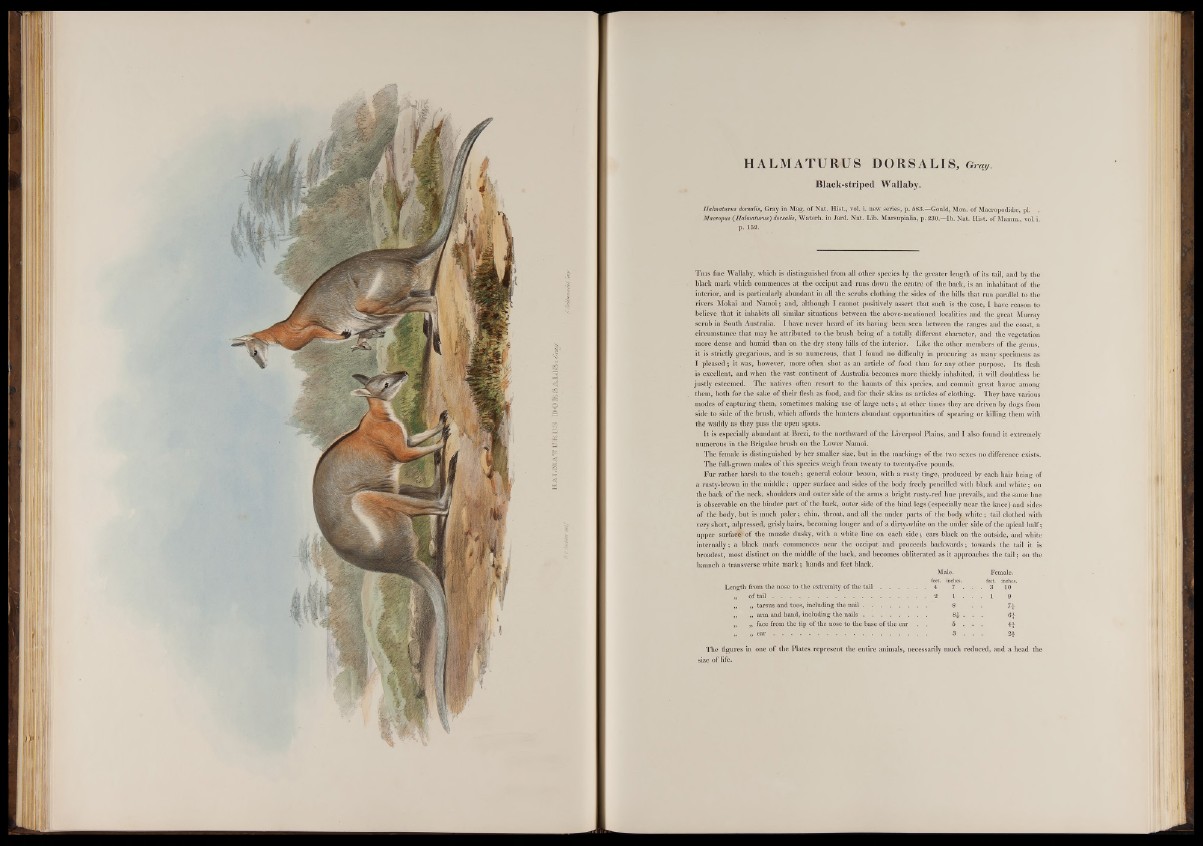
HA1LM AT UTIRUS ,©-© lÜ SAM S : Gray.
HALMATURUS DORSALIS, Gray.
Black-striped Wallaby.
Halmaturus dorsalis, Gray in Mag. of Nat. Hist., vol. i. new series, p. 583.—Gould, Mon. of Macropodidae, pi. .
Macropus (Halmaturus) dorsalis, Waterh. in Jard. Nat. Lib. Marsupialia, p. 230.—lb. Nat. Hist, of Mamm., vol. i.
p. 152.
T his fine Wallaby, which is distinguished from all other species hy the greater length of its tail, and by the
black mark which commences at the occiput and runs down the centre of the back, is an inhabitant of the
interior, and is particularly abundant in all the scrubs clothing the sides of the hills that run parallel to the
rivers Mokai and Namoi; and, although I cannot positively assert that such is the case, I have reason to
believe that it inhabits all similar situations between the above-mentioned localities and the great Murray
scrub in South Australia. I have never heard of its having been seen between the ranges and the coast, a
circumstance that may be attributed to the brush being of a totally different character, and the vegetation
more dense and humid than on the dry stony hills of the interior. Like the other members of the genus,
it is strictly gregarious, and is so numerous, that I found no difficulty in procuring as many specimens as
I pleased; it was, however, more often shot as an article of food than for any other purpose. Its flesh
is excellent, and when the vast continent of Australia becomes more thickly inhabited, it will doubtless be
justly esteemed. The natives often resort to the haunts of this species, and commit great havoc among
them, both for the sake of their flesh as food, and for their skins as articles of clothing. They have various
modes of capturing them, sometimes making use of large nets; at other times they are driven hy dogs from
side to side of the brush, which affords the hunters abundant opportunities of spearing or killing them with
the waddy as they pass the open spots.
It is especially abundant at Brezi, to the northward of the Liverpool Plains, and I also found it extremely
numerous in the Brigaloe brush on the Lower Namoi.
The female is distinguished by her smaller size, but in the markings of the two sexes no difference exists.
The full-grown males of this species weigh from twenty to twenty-five pounds.
Fur rather harsh to the touch; general colour brown, with a rusty tinge, produced by each hair being of
a rusty-brown in the middle; upper surface and sides of the body freely pencilled with black and white; on
the back of the neck, shoulders and outer side of the arms a bright rusty-red hue prevails, and the same hue
is observable on the hinder part of the back, outer side of the hind legs (especially near the knee) and sides
of the body, but is much paler; chin, throat, and all the under parts of the body white; tail clothed with
very short, adpressed, grisly hairs, becoming longer and of a dirty-wliite on the under side of the apical half;
upper surfac#- of the muzzle dusky, with a white line on each side; ears black on the outside, and white
internally; a black mark commences near the occiput and proceeds backwards; towards the tail it is
broadest, most distinct on the middle of the back, and becomes obliterated as it approaches the tail; on the
haunch a transverse white mark; hands and feet black.
Male. Female.
feet, inches. feet, inches.
Length from the nose to the extremity of the t a i l ..................... . 4 7 . . . 3 10
iy of t a i l ..................................................................................... . 2 1 . . . 1 9
„ „ tarsus and toes, including the n a i l ................................ 8
„ „ arm and hand, including the n a i l s ................................ | j . .
„ „ face from the tip of the nose to the base of the ear 5 . . H2
f
The figures in one of the Plates represent the entire animals, necessarily much reduced, and a head the
size of life.